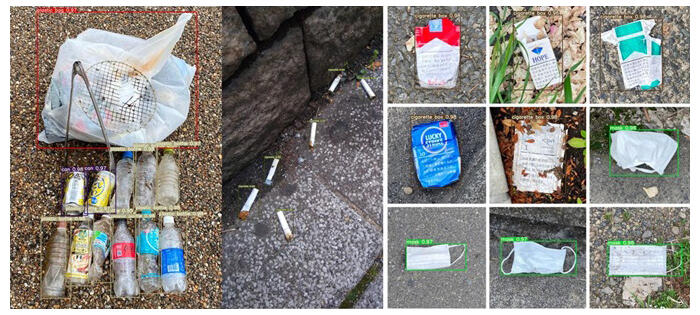A research group led by Professor Shin'ichiro Kako and Ryunosuke Muroya of the Graduate School of Science and Engineering, Kagoshima University, Group Leader Daisuke Matsuoka of the JAMSTEC Research Institute for Value-Added Information Generation, and Professor Atsuhiko Isobe of the Research Institute for Applied Mechanics at Kyushu University, announced on July 10 that they have developed a system that visualizes the amount of litter in streets by type using data from the smartphone app "Pirika," developed by Pirika, Inc. Involving the general public in data collection and presenting the effects of litter pickup in a visible form are expected to help promote litter pickup activities and marine pollution prevention in various regions. Participation in these litter pickup activities is expected over a wide area.

Provided by Kagoshima University
The system visualizes and quantifies litter in a city by combining information obtained through the "Pirika" smartphone app using deep learning. "Pirika" is an app that allows users to record and share their litter-picking activities by taking pictures of litter with their smartphone camera before picking it up. The app aims to promote litter collection activities by enabling the visualization of cleaning efforts and facilitating user interactions. "Pirika" is currently used in approximately 132 countries and has facilitated the collection of a total of 360 million pieces of trash (as of July). The app is available for download and use by anyone from the company's website (https://corp.pirika.org/sns-pirika/).
It is estimated that 80% of the ocean plastic pollution originates from household waste being washed into oceans from cities. To reduce this, it is important to understand the situation regarding litter disposal in urban areas, which are the source of pollution, and to take action accordingly. In addition, while litter in streets is cleaned up through litter-picking activities, until now, it has been difficult to estimate the extent to which these efforts contribute to the ongoing beautification of streets.
Since 2022, the research group has been working on analyzing litter in cities and developing methods for such an analysis using "Pirika." On this occasion, the research group developed a system that quantitatively evaluates the type and number of each litter item using an image analysis AI based on deep learning for the photographs of litter obtained by "Pirika." Litter could be classified into six types based on the images of dropped litter, including empty cans, cigarette butts, and plastic bags. In addition, the app's GPS information can capture the locations where these items have been dropped and record the number of items by type. Although it is difficult to distinguish between complex shapes such as food packaging, empty cigarette boxes and the like can be distinguished even if their shapes are deformed. Due to this, it is now possible to show on a map the type of litter that has been dropped, its location, and its quantity. Although "Pirika" offers limited functionality that ensures the ease of use by the general public, the analysis enables the clear understanding and evaluation of the effectiveness of cleanup activities. This discovery is expected to help municipalities and others formulate measures to reduce litter in cities and prevent it from flowing into oceans. The results were published in the June 28th online issue of the international journal Waste Management.
Kako said, "We would like to have a large number of people participate in the activities of trash pickup using 'Pirika' so that we can verify the effectiveness of the program. It is believed that litter in cities flows into the sea via rivers. In the future, we aim to realise continuous monitoring of the amount of litter in a wide area using remote sensing, e.g. webcams, drones and satellites. By developing technology that can track the movement of various types of litter together with information from apps, we believe that it will be possible to quantitatively assess where and to what extent the amount of town litter can be reduced to reduce the amount that flows out to sea."
Journal Information
Publication: Waste Management
Title: Quantification of litter in cities using a smartphone application and citizen science in conjunction with deep learning-based image processing
DOI: 10.1016/j.wasman.2024.06.026
This article has been translated by JST with permission from The Science News Ltd. (https://sci-news.co.jp/). Unauthorized reproduction of the article and photographs is prohibited.




